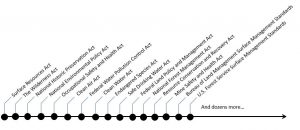Regulating U.S. Mining
Download ResourceRegulating U.S. Mining
THE MINING LAW OF 1872 AND THE COMPREHENSIVE STATE AND FEDERAL LAWS THAT GOVERN MINING
Mining is one of the most heavily-regulated industries in the world. The Mining Law of 1872 – which governs prospecting and mining for minerals like gold, copper, silver and lithium – led the U.S. to become a global leader in minerals mining, and helped advance innovations in energy, healthcare, manufacturing and defense technology. It is complemented by exhaustive modern federal and state environmental, ecological and reclamation laws and regulations to ensure that operations fully protect public health and safety, the environment, and wildlife.
More than three dozen federal environmental laws and regulations govern the U.S. mining industry — in addition to laws at the state and local level.
Dozens of environmental and regulatory requirements ensure mining operations maintain the highest possible standards for safety and the environment. Given the applicability of the National Environmental Protection Act, Endangered Species Act, Clean Water Act, Clean Air Act, National Historic Preservation Act and other laws, including environmental standards in the text of the General Mining Law would create inconsistencies and uncertainty, while providing no additional environmental benefit. The National Academy of Sciences has concluded that the existing set of state and federal regulations are comprehensive and effective.
Mining’s contributions to the U.S. economy are substantial. Unnecessary changes  to the Mining Law of 1872 will impair U.S. global competitiveness, depress employment, and reduce tax revenues at the federal and state level.
to the Mining Law of 1872 will impair U.S. global competitiveness, depress employment, and reduce tax revenues at the federal and state level.
- The U.S. mining industry directly and indirectly employs more than 1.5 million individuals paying in excess of $95 billion in labor income.
- In 2017, domestic mining activity generated an estimated $17 billion in federal, state and local taxes that supported direct, indirect and induced taxes of $42 billion.
- The U.S. mining industry pays between 40 to 50 percent of earnings in federal, state and local royalties, taxes and other fees to benefit the communities in which it works and the U.S. federal government.
Our economy and national defense depend on a strong domestic mining industry, utilizing our nation’s vast minerals reserves. Duplicative regulations and restrictions put critical U.S. supply chains for the manufacturing, infrastructure and defense industrial sectors at risk.
- According to the U.S. Geological Survey, the U.S. is 100 percent import reliant for 18 minerals – 14 of which have been deemed “critical” by the Secretaries of Defense and the Interior – and more than 50 percent import reliant for another 30 minerals.
- New mining operations are already either restricted or banned on more than half of all federally-owned public lands, and mining is not permitted in national parks, wilderness areas, wildlife refuges, recreation areas and more. This means a significant percentage of our nation’s mineral resources that reside on federal lands are already off limits. The current extensive environmental laws thoroughly protect land that remains open to mining.